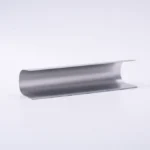When you buy polished stainless tubing, you are choosing two things: the grit that sets the look, and the Ra that sets cleanability. Put both on the PO—outside (OD) and, if it matters, inside (ID)—and note what you want at the weld seam.
Grit vs Ra—how they relate
The same grit can yield different Ra depending on base finish (2B/BA), hardness and polishing method. Use these ranges as guides and confirm your target Ra on samples:
| Grit (OD) | Look | Typical Ra | Common uses |
|---|---|---|---|
| 180 | Satin, visible lines | ~1.2–1.6 μm | Guards, racks |
| 240 | Smoother satin | ~0.8–1.2 μm | Furniture, architectural |
| 320 | Fine satin | ~0.4–0.8 μm | Handrails, cleanroom |
| Mechanical mirror | Bright | ~0.1–0.3 μm | Decorative |
| Electropolished | Bright, leveled | ~0.2–0.5 μm or better | Sanitary |
Material choices
- 304/304L: general indoor; food ok if chlorides are low.
- 316/316L: better pitting resistance; safer for aggressive cleaners and coastal sites.
Weld seam & ID finish
- As-welded vs ground-flush seam; smooth flow/sanitary needs blending.
- ID options: pickled & passivated, mechanically polished ID, electropolished ID.
- State the Ra target and the standard/cutoff (e.g., ISO 4288, 2.0 mm).
Recipes
- Handrails: 304, OD 320 grit; ID pickled; film-protected.
- Food frames: 304L, OD 240–320; welds blended; passivated.
- Coastal/chemicals: 316L, OD 320 or electropolish; set ID Ra if used for fluids.
- Sanitary: 316L, ID electropolished to Ra ≤0.5 μm; OD 320+.
Spec (copy/paste)
- Tube: 316L welded, 50.8 × 1.5 mm
- Finish: OD 320‑grit, Ra ≤0.8 μm; seam blended
- ID: Pickled & passivated (or electropolished to Ra ≤0.5 μm)
- Docs: 3.1 MTC; Ra report on request
- Packing: Sleeved, film-protected, capped ends
Internal links
Baoli Engineering Team · Reviewed Oct 31, 2025




